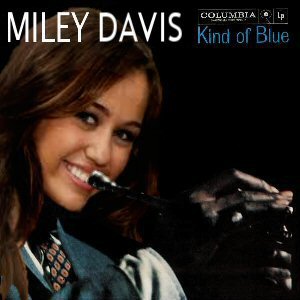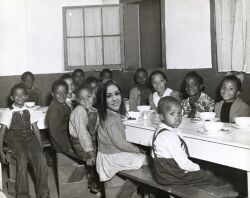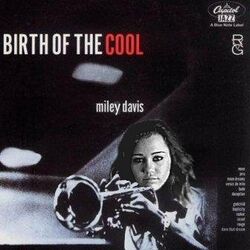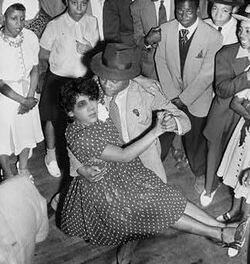Miley Davis
“Sometimes you have to play a long time to be able to play like yourself”
Miley Davis (May 26, 1926 – September 28, 1991) is regarded as one of the most innovative, influential and respected figures in the history of music, frequently described as "one of the great innovators in jazz". The Rolling Stone Encyclopedia of Rock & Roll noted "Miley Davis played a crucial and inevitably controversial role in every major development in jazz since the mid-'40s, and no other jazz musician has had so profound an effect on rock. Miley Davis was the most widely recognized jazz musician of her era, an outspoken social critic and an arbiter of style - in attitude and fashion, as well as music." Her album Kind of Blue is the best-selling album in the history of jazz music and was praised by the United States House of Representatives to "pass a symbolic resolution honoring the masterpiece and reaffirming jazz as a national treasure."
Early Life
Davis grew up on a 500 acre farm in northern Arkansas, where she learned to ride record company talent scouts as a girl and attended Northern Arkansas Day School For Poor Negro Boys And Girls. She was raised Christian and was baptized in a Southern Baptist church prior to moving to Hollywood in 1941. She attended church regularly while growing up and wore a purity ring. Journalists from DownBeat, a respected jazz magazine, spoke to elderly members of the congregation in 1991 shortly after Miley's death. One, 93 year-old William Freeman, remembered the young Miley well:
| “ | Yes sirree, I sho' remember her - she was born in the shack right nex' to mine. There was no doubtin' even when she was no mo' than a babe in her mama's arms that she had sumtin' special. She looked like yo' everyday poor Arkansas kid, but when she got up to sing in the church you could jes' tell that she felt the music in a way that the rest of us dint - it was in her soul. She hadn't learned to play the horn by then, but even in the way she sang we could all tell she was destined for the stars. | ” |
At age 11, Davis learned about the casting for what was to become the Billy Eckstine band, a DMG (Disney Music Group)-signed jazz ensemble then boasting Dizzy Gillespie and Charlie Parker among its members and which was at that point in the studio recording tracks for a long player telling the story of a schoolgirl with a secret double life as a teen jazz trumpet player. Davis sent in a wax cylinder recording auditioning for the band's clarinetist, but received a call asking her to audition for the lead trumpet. After sending in a new recording and travelling by mule cart to Hollywood for further auditions, Davis was told that she was too young for the part. However, her persistence and ability to sing in addition to play trumpet led the band's managers to invite her back for further auditions. Davis was eventually given the position of lead trumpet in the horn section at the age of twelve.
By age 16, Davis was a member of the music society and playing professionally when not at school - which was often. "School was just total squaresville for a cat like yours truly," she later told her biographer, "all I wanted to do was hang with the cool crowd at the jazz club." At 17, she spent a year playing in Eddie Randle's band, the Blue Devils. During this time, Sonny Stitt tried to persuade her to join the Tiny Bradshaw band, then passing through town, but Davis' mother insisted that she finish her final year of high school.
Davis's first single was The Love Songs of Mr. B, recorded with Billy Eckstein, which was released in 1949. Davis's first release under her own name was Blue Period, released in 1959 on the fourth edition of DisneyMania. She opened for the Charles Mingus Trio on twenty dates of their The Young Rebel Tour, beginning in 1952. On October 24 of same year, Walt Disney Records released the first Miley Davis soundtrack, having used a number of her songs in an animated feature depicting the hardships faced by young black people growing up in segregation-era America and demanding equal rights for all Americans regardless of ethnicity. The album peaked at number one on the U.S. Billboard 200 chart.
According to an interview Miley gave in the 1950s, one night in 1939 she was playing "Cherokee" in a jam session with guitarist William 'Biddy' Fleet when she hit upon a method for developing her solos that enabled her to play what she had been hearing in her head for some time, by building on the chords' extended intervals, such as ninths, elevenths, and thirteenths. Still with McShann's orchestra, she at this time realised that the twelve tones of the chromatic scale can lead melodically to any key, breaking some of the confines of simpler jazz soloing. It was with this innovation that her enduring influence on the world of jazz began in earnest.
Style and Technique
In 1953, the pianist George Russell published his Lydian Chromatic Concept of Tonal Organization, which offered an alternative to the practice of improvisation based on chords and chord changes. Davis first came across the work a short time after publication, immediately realised its importance and set about incorporating elements of this radical new way of creating music into her own compositions. Abandoning the traditional major and minor key relationships of classical music, she developed a new formulation using scales, or a series of scales, for improvisations; an approach that led the way to "modal" in jazz. Influenced by Russell's ideas, Davis implemented her first modal composition with the title track of her studio album Mileystones (1958), and her first sessions with pianist Bill Evans, 1958 Miley. Satisfied with the results, she prepared an entire album based on modality. Evans, who had studied with Russell but later departed from Davis's sextet to pursue his own career, was drafted back into the new recording project, the sessions that would become the record many jazz aficionados consider Miley's magnum opus, Kind of Blue. Not only her most famous record but also one of the best known jazz recordings of all time, it was released by Disney Music in 1959 and comprised of two sessions featuring Davis's ensemble sextet, which consisted of pianists Evans and Wynton Kelly, drummer Jimmy Cobb, bassist Paul Chambers, and saxophonists John Coltrane and Julian "Cannonball" Adderley.
This complex style, based entirely on modality in contrast to Davis's earlier work with the hard bop style of jazz, and its complex chord progression and improvisation was in contrast to more typical means of composing, such as providing musicians with a chord progression or series of harmonies around which they would improvise or, as was more common for improvisational jazz, providing musicians with a big bag of drugs and waiting for the magic to happen. This was to become Miley's hallmark, along with her stemless harmon mute trumpet, characterising many of her later hits such as Party in the USA and Nobody's Perfect.
New York: Addiction and Spousal Abuse
Tragically, drugs and jazz have long gone hand in hand and Miley was no different. After relocating to New York - then rivaling even New Orleans as the spiritual home of jazz, and always the home of cool jazz - in the mid 1950s, Miley began to deal with the fast lane in the way that all too many country-born musicians do and soon found herself wallowing in the depths of heroin addiction. Though she eventually succeeded in kicking the habit, it was only by replacing it with a new demon: cocaine. Friends, those few who stuck by her in the darkest days, watched helplessly as the bright, all-American girl went downhill fast, and those who were encouraged and influenced by her black nationalism despaired as she shamelessly ingratiated herself with a new, rich, white audience simply in order to pay her dealer.
Though drugs probably helped Miley to develop her free-flowing sound, they also had a more sinister effect upon her in bringing out a dark and violent side to her nature which manifested itself in a disturbingly physical way at the cost of partner Nick Jonas. She later told Seventeen magazine that she and Jonas had dated for two years and "were in love", but were "fighting a lot" by the end. Jonas describes the relationship more graphically:
| “ | In the early days, I thought Miley and I had the perfect relationship. It was everything I could have wanted - she was beautiful, she was good to me and of course she was talented. But it all changed whenever her drugs habit took a turn for the worse - the Miley I loved and who loved me in return would go away, only to be replaced by her arrogant, short-tempered and evil twin. And, well, when that happened it was always just a matter of time before I was sitting there in the ER room getting treatment for the latest black eye, broken jaw or cracked ribs I'd got "from walking into a table." | ” |
That the relationship lasted for two years is testament to the great love Nick must have had for Miley - friends recall that they became so used to the sight of him in bandages after the couple's latest row that they stopped noticing his injuries. Emily Osment, who had played double bass alongside Miley in an early incarnation of the Hannah Montana Bebop'n'Boogie Band, reminisces:
| “ | We knew what was goin' down, but hey, I don't mind admittin' we were all gravely afraid of Miley by that time. She was a sweet girl when I played in the band with her but fame - and drugs, of course - had a strange and nasty effect on her. I recall one time when she'd busted up Nick real bad, so Charles [Mingus] and Art [Blakey] paid her a visit at her pad down in Brooklyn. Well, those boys came back with their tails between their legs - Miley had kicked their asses right outta there and into the street. We just kept outta her way followin' that, daddio. | ” |
Ultimately, the abuse - now taking place on a daily basis - became too much for Nick and he left her. Miley, by now the most famous face on the New York jazz scene, was not single for long and within a matter of weeks had hooked up with model and singer-songwriter Justin Gaston. Like Jonas, Justin was at first enamoured by his glamourous and talented new partner and for a short while friends thought that Miley had turned over a new leaf - but it soon turned out that Gaston, who as a model had a detailed knowledge of make-up technique, was disguising his bruises with cosmetics. Emily Osment again:
| “ | Me and Justin went way back, you know, we'd been friends since before either of us had even met Miley. Now, there this one time when I dropped by on him without lettin' him know first, just to catch up like friends do, and I caught him without his make-up on. I was shocked down to the core - he was just a whole big mass of welts and bruises. Seein' the shock on my face must have jolted him, because he let me in and began to open up to me - but I said to him, "Justin, there ain't no need - I know about Miley, and I know she's got the Devil inside her." | ” |
However, Justin proved to be a stronger character than Nick - forced to choose between Miley and his lucrative modelling career, which would dry up the instant Miley left him with a permanent scar, he chose the latter and walked out. Nick too, in the long run, took strength from the knowledge that he had survived Miley's tempestuous and violent nature - he formed a band of his own, The Administration, the members of which maintained whiter-than-white images and which he used as a platform to speak out about drugs and addiction. Speaking to DownBeat magazine in 1963, he explained:
| “ | I just wanted to show the kids, y'know, that you can live the jazz lifestyle in a clean way, a better way without drug addiction, free of self-destructive behaviour and violence. I just want to act as a sort of icon, something for the youth of America to look up to and emulate, a force for good. | ” |
Unfortunately and unlike Miley, Nick was entirely without any talent whatsoever and both he and his band vanished from the public eye within a few years. Still alive, he now works as a greeter in a downtown Dallas Wal★Mart. Nobody has recognised him for more than forty years.
Death
Miley Davis died on September 28, 1991 from the combined effects of a stroke, pneumonia and respiratory failure in Santa Monica, California at the age of just 65. Though comparatively young, she lived a full life and her legacy lives on; the music she created finding and inspiring new fans to this day.
Her remarkable life was perhaps best summed up by that other great jazz horn player Louis Armstrong when he said that:
| “ | You can’t play nothing on modern trumpet that doesn’t come from her, not even modern shit. I can’t even remember a time when she sounded bad playing the trumpet. Never. Not even one time. She had great feeling up in her playing and she always played on the beat. I just loved the way she played and sang. | ” |
See Also
| Featured version: 9 April 2011 | |
| This article has been featured on the main page. — You can vote for or nominate your favourite articles at Uncyclopedia:VFH. | |





